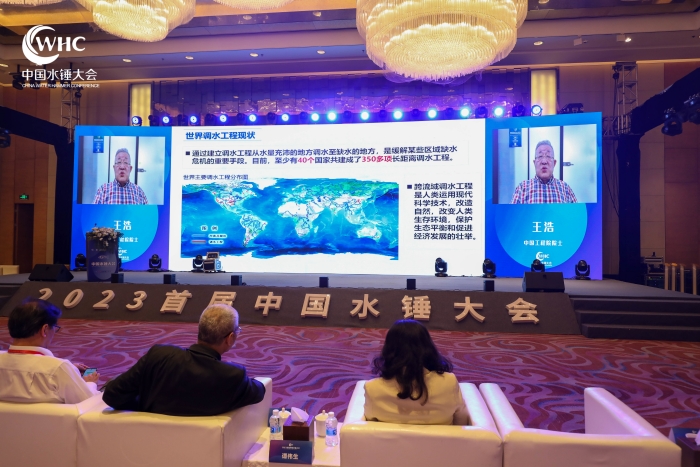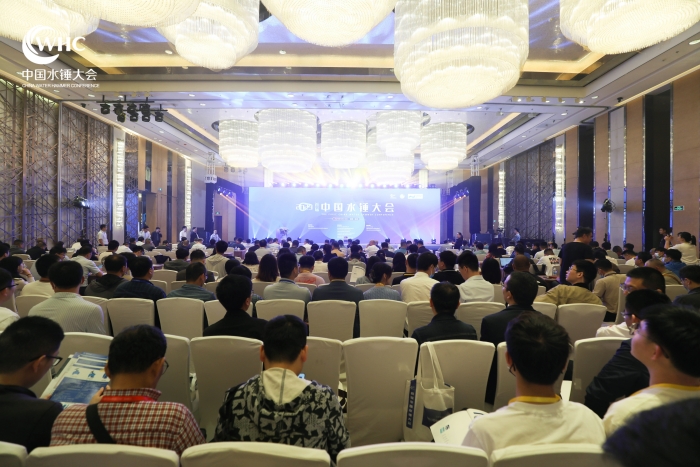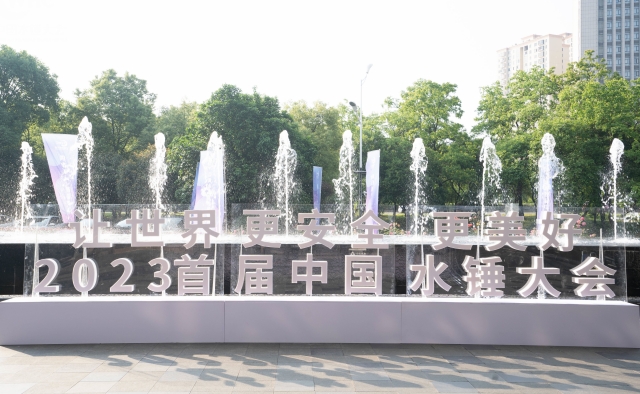On behalf of GWP China, Yunzhong JIANG, regional coordinator, attended and delivered an opening speech to the session, along with Xinhua TANG, vice president and secretary-general of Chinese Hydraulic Engineering Society, and Xianghui JIANG, vice mayor of Zhuzhou Municipal People's Government.
In his speech, Yunzhong pointed out that strengthening scientific research and application innovation in the field of water hammer is an important topic and glorious mission that each water practitioner faces. The first China Water Hammer Conference provides a good platform for exchanges and cooperation in this field, and a sustainable development of water hammer protection technology and practice. According to Prof. JIANG, there are approximately 2 billion pumping stations worldwide, which have had a significant impact on humanity, the environment, and the economy. Safe and reliable fluid delivery systems are crucial for today's world. In water diversion projects, urban-rural water supply and drainage projects, water hammer is a common engineering and technical challenge to the global water supply industry. Everyone engaged in research, design, construction, operation, and equipment manufacturing in the water supply industry must be aware of the potential consequences of water hammer. In recent years, with the orderly progress of the national water network construction, China has built the world's largest, largest, and most beneficial water conservancy infrastructure system, solving the technical problems of water hammer protection in many large, long-distance, and high lift projects, and forming a series of internationally leading technologies and experience practices. Therefore, strengthening scientific research and application innovation in the field of water hammer is an important topic and glorious mission that every water industry worker faces. The predecessor of the International Water Hammer Conference was held in 1970 and 1971, and it has been held for 14 consecutive sessions since 1972, making it a leading conference in this field. Water Hammer Conference is an academic event in the field of water resources and water security.
After the opening, GWP China Vice Chair, Hao WANG, Academician of the Chinese Academy of Engineering was invited to deliver a keynote report. He introduced the 'Water Hammer Problem in Water Diversion Projects', as well as the solutions and key technical content in his keynote speech. He said, "Regarding rivers, we need to build dams and gates for water volume regulation. Pipeline water hammers are also equipped with a large number of pumps and valves to regulate the water volume and pressure inside the pipeline. Water hammers are the main harm to the pipeline system. When it is necessary to increase the production of water supply projects, water hammers block our path, damaging pump stations, pipelines, and valves, becoming a bottleneck that restricts the operational efficiency of water supply projects." As Academician Wang said, the water diversion project is a typical complex system with time-varying, nonlinear, and multivariable hydraulic fragility characteristics. During normal scheduling and emergency conditions, any factor that causes rapid changes in hydraulic state may generate water hammer risks, which are sudden and uncertain. The essence of water hammer is the gradient change of flow velocity inside the pipeline. For example, on highways, the risk of high-speed cars is not high. Once the vehicle condition is complex, sudden braking occurs, and the speed suddenly changes, various accidents are prone to occur. Water hammer is a traffic accident in the water supply network and is affected by the entire complex system. The proposal of digital twins brings opportunities for systematic protection of water hammer. Building a water hammer protection system from hardware to software using new generation information technology and achieving intelligent scheduling of water supply projects is a breakthrough to solve this problem. He shared audiences an intelligent scheduling system for water hammer protection in water supply engineering based on digital twins. Hao WANG said, "In the pipeline system, in the past, our intelligent scheduling focused on the scheduling of upstream and downstream gates, storage tanks, pump stations and other main channel systems, focusing on achieving long-term and overall water delivery and scheduling goals. And this system will become an effective supplement, integrating adaptive water hammer protection, pipeline water hammer monitoring, online hydraulic model, transient process scheduling, pump pipe valve joint debugging and control, to achieve precise and real-time scheduling within the pipeline." He also elaborated four transformative technologies and their economic and social benefits in the water diversion project.
Water hammer is a serious safety issue for any high-production hydraulic facility. Your hydraulic piping system will continue to abnormally pulsate until it causes severe damage. Quick closing valves, positive displacement pumps, and vertical pipe runs can create damaging pressure spikes, leading to blown diaphragms, seals and gaskets also destroyed meters and gauges. Liquid for all practical purposes is not compressible, any energy that is applied to it is instantly transmitted. This energy becomes dynamic in nature when a force such as quick closing valve or a pump applies velocity to the fluid.
Surge or water hammer, as it is commonly known is the result of a sudden change in liquid velocity. Water hammer usually occurs when a transfer system is quickly started, stopped or is forced to make a rapid change in direction. Any of these events can lead to catastrophic system component failure. Without question, the primary cause of water hammer in process applications is the quick closing valve, whether manual or automatic. A valve closing in 1.5 sec. or less depending upon valve size and system conditions, causes an abrupt stoppage of flow. The pressure spike(acoustic wave)created at rapid valve closure can be high as five (5) times the system working pressure.
The Water Hammer Workshop gathered the experts and practitioners towards a brainstorming, on one hand, to avoid situations that will create water hammer or pulsations during the specification process. On the other hand, while trouble shooting, people can eliminate a lot of problems, failed valves and equipment, and costly downtime. It was hosted by GWP China and Chinese Hydraulic Engineering Society, co-organized by Zhuzhou Nanfang Valve Co., Ltd., State Key Laboratory of Basin Water Cycle Simulation and Regulation, Water Resources Professional Committee of Chinese Hydraulic Engineering Society, Water Diversion Professional Committee of Chinese Hydraulic Engineering Society, Water System Engineering and Technology Branch of China Survey and Design Association, Underground Pipeline Professional Committee of China Surveying and Mapping Society. The event also was kindly supported by Hebei University of Engineering and the Key Laboratory of Digital Twin Watershed of the Ministry of Water Resources (preparatory), Water Conservancy Society of Hunan Province, the hydraulics Professional Committee of Chinese Hydraulic Engineering Society, and the Pump and Pumping Station Professional Committee of Chinese Hydraulic Engineering Society.
